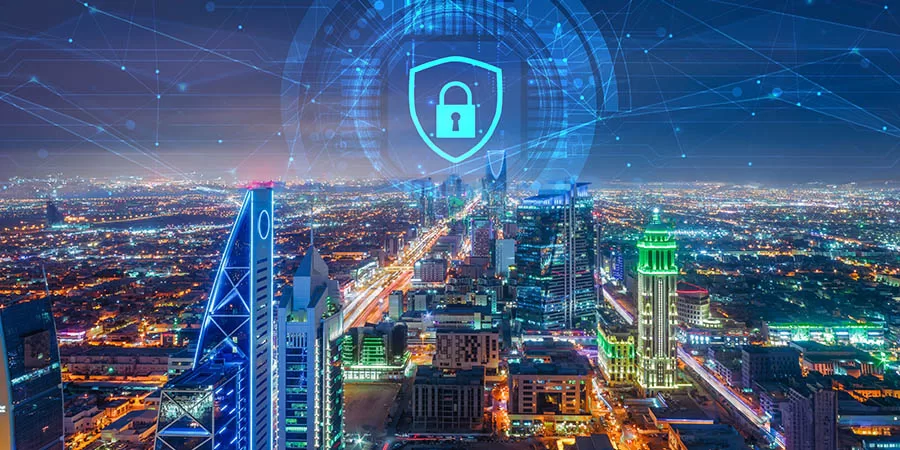The Need for Robust Cybersecurity Measures
As Saudi Arabia accelerates its digital transformation under Vision 2030, the nation has become a prime target for cyber threats. The Kingdom ranks among the top Middle Eastern nations investing in cybersecurity, with increased focus on compliance, resilience, and data protection. The regulatory bodies overseeing cybersecurity include:
- National Cybersecurity Authority (NCA) – Establishes national security frameworks such as ECC-2.
- Saudi Data and Artificial Intelligence Authority (SDAIA) – Oversees data protection regulations like the Personal Data Protection Law (PDPL).
- Communications and Information Technology Commission (CITC) – Regulates cloud security and digital risk frameworks.
With compliance requirements tightening, organizations must implement end-to-end cybersecurity measures to prevent breaches, protect customer data, and ensure operational continuity.
Comprehensive Cybersecurity Service Offerings in Saudi Arabia
To safeguard organizations from cyber threats and ensure compliance with local regulations, a multi-layered approach to cybersecurity is essential. Below are the core cybersecurity services tailored for businesses in Saudi Arabia:
1. Regulatory Compliance and Risk Management
Ensuring adherence to Saudi cybersecurity regulations is crucial for business operations. Key services include:
- ECC-2 Implementation – Aligning with NCA’s Essential Cybersecurity Controls to strengthen cybersecurity governance.
- PDPL Compliance – Adhering to the Saudi Personal Data Protection Law (PDPL) for secure data handling.
- Cloud Computing Regulatory Framework (CCRF) Compliance – Meeting CITC’s requirements for cloud security.
- Risk Management Framework (RMF) Implementation – Establishing proactive cybersecurity risk management strategies.
2. Incident Response and Digital Forensics
Cyber incidents can disrupt operations, making swift response mechanisms essential:
- Incident Response Planning – Aligning with ECC-2 Control 3.3 to develop robust response strategies.
- Forensic Investigations – Providing digital forensics services to trace cyberattacks and breaches.
- Ransomware Mitigation – Implementing security controls to detect and mitigate ransomware threats.
3. Managed Security Services (MSS) for Continuous Protection
With cyber threats evolving, 24/7 security monitoring is critical for real-time protection. Key offerings include:
- Security Operations Center (SOC) as a Service – Continuous monitoring and threat detection.
- Threat Intelligence Integration – Leveraging real-time threat feeds for proactive cybersecurity defense.
- Operational Technology (OT) Security Monitoring – Protecting industrial control systems from cyber threats.
4. Attack Surface Management (ASM) for Proactive Security
Organizations must continuously monitor their attack surface to mitigate vulnerabilities:
- Continuous Asset Discovery – Identifying shadow IT and unauthorized assets.
- Real-time Threat Monitoring – Providing continuous scanning to detect vulnerabilities.
- Security Posture Improvement – Addressing security weaknesses before they are exploited.
5. Data Protection and Privacy Compliance
Protecting sensitive data is a priority under Saudi laws. Services include:
- Data Protection Impact Assessments (DPIA) – Ensuring PDPL compliance and risk mitigation.
- Data Localization Strategy – Meeting local data residency laws.
- Data Classification and Encryption – Implementing security controls for structured and unstructured data.
6. Penetration Testing and Vulnerability Assessment
Regular security assessments are essential to identify vulnerabilities before hackers do:
- Red Team and Blue Team Exercises – Simulating real-world cyberattacks to strengthen defenses.
- Compliance-Based Penetration Testing – Meeting ECC-2 and PDPL security testing requirements.
- Continuous Vulnerability Scanning – Using automated tools for ongoing security posture assessments.
7. Digital Risk Protection and Brand Monitoring
Organizations must safeguard their online presence against cyber threats:
- Phishing and Domain Monitoring – Preventing impersonation and domain spoofing attacks.
- Dark Web Monitoring – Detecting leaked credentials and compromised company assets.
- Brand Protection Services – Identifying and taking down fraudulent online activities.
8. Third-Party Risk Management
Vendors and third parties pose cybersecurity risks that must be mitigated:
- Vendor Risk Assessments – Evaluating cybersecurity readiness of third-party suppliers.
- Supply Chain Risk Monitoring – Detecting vulnerabilities in external business networks.
- Third-Party Incident Response Planning – Ensuring quick resolution of supply chain-related breaches.
9. Cybersecurity Training and Awareness Programs
A strong security culture reduces human-related cyber risks. Key offerings include:
- Security Awareness Training – Conducting phishing simulations and interactive training sessions.
- Executive Cybersecurity Workshops – Educating leadership on cyber risk management.
- Industry-Specific Cybersecurity Training – Tailored programs for banking, healthcare, and critical infrastructure sectors.
10. Identity and Access Management (IAM) for Secure Access Control
Ensuring proper user authentication and access control is vital for cybersecurity resilience:
- Zero Trust Architecture Implementation – Reducing reliance on traditional perimeter security.
- Multi-Factor Authentication (MFA) – Enhancing security with biometric and token-based authentication.
- Privileged Access Management (PAM) – Protecting sensitive accounts from unauthorized access.
11. Secure Digital Transformation Advisory
As organizations adopt new technologies, secure digital transformation is essential:
- Cloud Security Posture Management – Ensuring compliance in hybrid and multi-cloud environments.
- AI-Driven Security Strategies – Using artificial intelligence for advanced cyber threat detection.
- Zero Trust Security Frameworks – Implementing end-to-end zero-trust strategies for digital resilience.
Conclusion
Saudi Arabia’s commitment to cybersecurity is evident through its regulatory frameworks, investment in emerging technologies, and focus on digital resilience. As cyber threats grow in complexity, businesses must adopt comprehensive security measures to safeguard operations, ensure compliance, and build trust with stakeholders.
By implementing a well-rounded cybersecurity strategy—spanning regulatory compliance, threat detection, risk management, and digital resilience—organizations can proactively mitigate risks and contribute to a secure, innovative digital economy under Vision 2030. The road ahead demands continuous adaptation to emerging threats, investment in advanced security technologies, and fostering a culture of cybersecurity awareness.
Businesses that prioritize cybersecurity today will be well-positioned to navigate the evolving cyber landscape of tomorrow, ensuring long-term success and resilience in Saudi Arabia’s fast-growing digital economy.
By leveraging these cybersecurity service offerings, organizations can meet NCA, SDAIA, and CITC compliance requirements, protect critical infrastructure, and ensure a secure digital transformation journey aligned with Vision 2030.
Prime Infoserv is just a call away for any detailed discussions on any of these topics.




